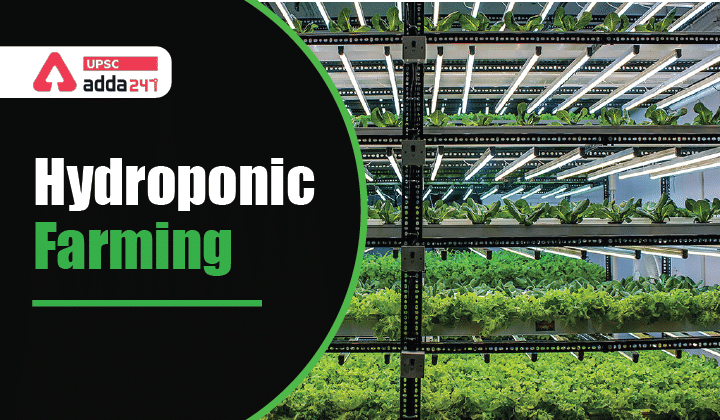What is Hydroponic Farming?
- Hydroponics is a method of growing plants in a water-based, nutrient-rich solution.
- The roots are suspended in a purified water system that is enriched with nutrients.
- Instead of using soil, the root system is supported using an inert medium such as perlite, Rockwool, clay pellets, peat moss, or vermiculite.
- Hydroponic Farming Farms can be set up in a space as small as a cubicle-sized room fitted with a tech support system that creates an artificial environment conducive for growth.
- These hi-tech, sustainable farms, operate on the science and principles of hydroponic farming — a soil-free farming technique.
- Hydroponics allows the plants’ roots to come in direct contact with the nutrient solution while also having access to oxygen, essential for proper growth.
- In hydroponic farming, plants grow naturally, drawing nutrients out of reservoirs filled with nutrient-rich and water-based solutions, under optimal positioning of lights and regulated temperature conditions.
Challenges and Opportunities for Hydroponic Companies in the Pharma Sector
- In the pharma industry, hydroponics can be used to cultivate nutraceutical compounds and botanical extracts, especially for Indian traditional medicine systems.
- Hydroponics as cultivation technology is well-suited for the growth of medicinal herbs.
- Studies have proven that the plants and herbs grown in this method have more nutritional content than traditional agricultural practices, mainly due to the controlled environment and constant monitoring.
- Plants such as ashwagandha, ginger, turmeric, Shatavari, etc., are easy to grow in this technique.
- Pharma and nutraceutical industries have more stringent guidelines and standards to maintain, which can be challenging to adhere to for small-scale farmers.
- There is also a need to invest in R&D to customise hydroponics techniques to cultivate medicinal plants, especially as the nutrient content and bioavailability of nutrients is of paramount importance.
- This can increase the burden of the already capital-intensive technology.
Techniques used in Hydroponics
- Under hydroponics, terrestrial plants can be grown in multiple ways.
- The most common ways involve exposing roots to nutritious liquid, or in some cases, the roots can be physically supported by an inert medium such as perlite or gravel.
- These devices enable people to set up equipment within the confines of houses and grow vegetation.
- The two most commonly deployed systems in hydroponics are the Nutrient Film Technique (NFT) and Deep Water Culture (DWC).
- In NFT, a shallow stream of water containing dissolved nutrients is re-circulated through bare roots in a watertight thick tube, which forms a mat-like layer from which the roots absorb nutrients. An abundant supply of oxygen is provided to the roots through the process.
- Under DWC, roots are left suspended in nutrient-rich, oxygenated water. The solution is saturated with oxygen-infused by an air pump in the presence of porous stones. The method is touted to be more suitable for plants’ faster growth, given the high level of oxygen that roots receive.
Cons
- It involves a complex setup and the running and maintenance costs are huge.
- The technique requires some amount of expertise to be practised.
- For instance, the ICAR-CPRI in Shimla has been following the aeroponic seed production system since 2011.
- This is hydroponics in a lot of ways, except that the process doesn’t need a medium like sand, gravel or water.
Pros
- It is a process of fast multiplication of high-quality planting material producing about 35-60 mini-tubers per tissue culture plantlet.
- It reduces the water requirements of plants by a marked extent since the medium in which they grow is solvent-based.
- With hydroponic farming, monoculture is not an issue and the practise is readily possible in areas where climatic or geographical conditions pose a barrier.
- It uses 80-90% less water, 80-95% less land, harmful pesticides can be avoided and vegetables can be grown all year round.
- The yield of hydroponic farming is also substantially higher than that of traditional agriculture.
- Yields are almost 2.5 times more than it is through traditional means. People can claim more, but it is almost 2.5 times in reality.
- That’s primarily because one can grow more plants compared to ground agriculture, and the plants grow at a faster pace.
How active and aware is the Indian government about hydroponic farming?
- Both central and state governments have subsidies for capital costs incurred for hydroponic farmers.
- The percentage of subsidies differs from state to state, ranging anywhere between 20 and 60 per cent.
- Hydroponic farmers can also avail of credit-linked assistance from the National Horticulture Board under its hi-tech horticulture project.
- There is still ambiguity in governmental sops and tax credits.
- A clear vision from the government can help in increasing the growth of hydroponics in India.



 TSPSC Group 1 Question Paper 2024, Downl...
TSPSC Group 1 Question Paper 2024, Downl...
 TSPSC Group 1 Answer key 2024 Out, Downl...
TSPSC Group 1 Answer key 2024 Out, Downl...
 Cabinet Ministers of India 2024, New Cab...
Cabinet Ministers of India 2024, New Cab...







